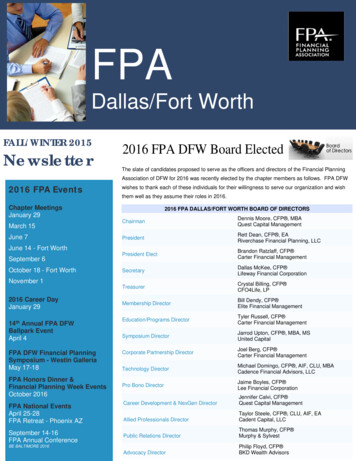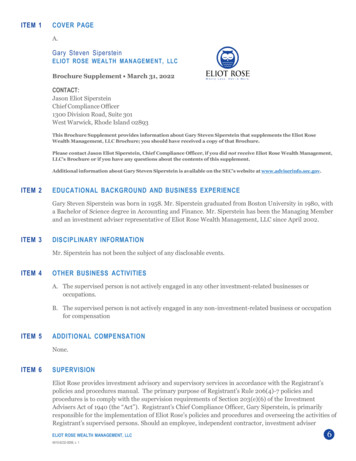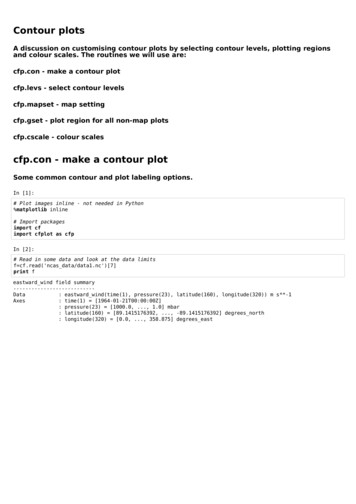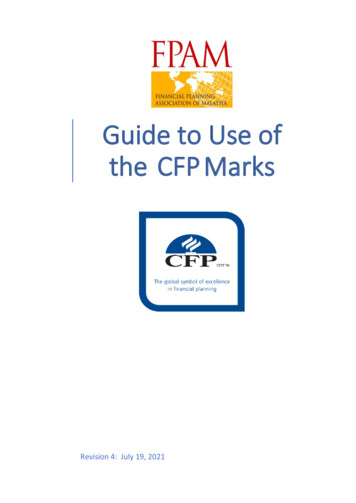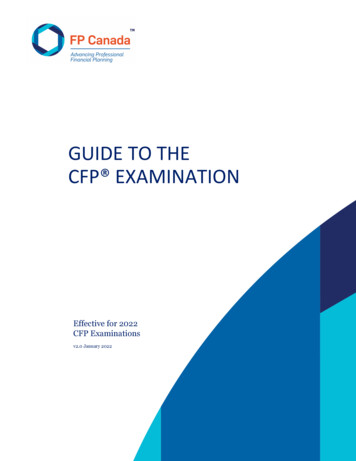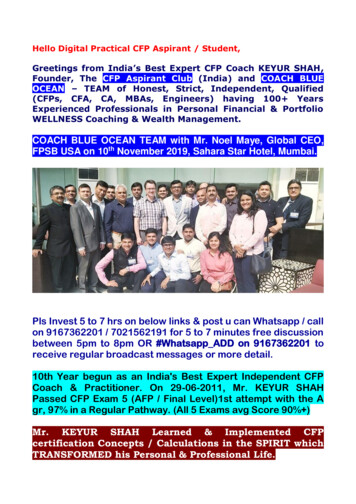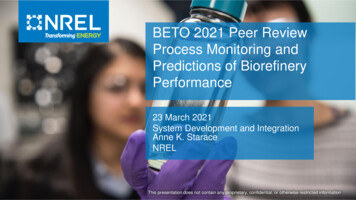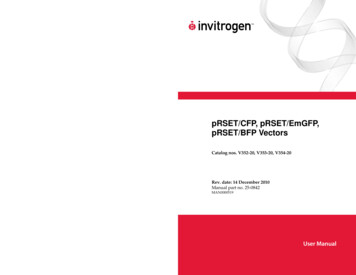
Transcription
pRSET/CFP, pRSET/EmGFP,pRSET/BFP VectorsCatalog nos. V352-20, V353-20, V354-20Rev. date: 14 December 2010Manual part no. 25-0842MAN0000519Corporate HeadquartersInvitrogen Corporation1600 Faraday AvenueCarlsbad, CA 92008T: 1 760 603 7200F: 1 760 602 6500E: tech support@invitrogen.comFor country-specific contact information visit our web site at www.invitrogen.comUser Manual
ii
Table of ContentsKit Contents and Storage .ivIntroduction. 1Product Overview . 1Methods . 5General Information . 5Expression of Fluorescent Protein in E. coli . 6Purification and Detection of Fluorescent Protein. 7Appendix . 8pRSET/CFP, EmGFP and BFP Vectors . 8Recipes . 10Accessory Products. 11Technical Support . 12Purchaser Notification. 14References . 17iii
Kit Contents and StorageShipping andStoragepRSET vectors are shipped on wet ice. Upon receipt,store vectors at –20 C.Kit ContentsAll vectors are supplied as detailed below. Store thevectors at –20 C.Catalogno.CompositionAmountV352-20 pRSET/CFP20 L of 0.5 g/μL vector in10 mM Tris-HCl, 1 mM EDTA,pH 8.010 gV353-20 pRSET/EmGFP20 L of 0.5 g/μL vector in10 mM Tris-HCl, 1 mM EDTA,pH 8.010 gV354-20 pRSET/BFP20 L of 0.5 g/μL vector in10 mM Tris-HCl, 1 mM EDTA,pH 8.010 gIntended UseivVectorFor research use only. Not intended for human oranimal diagnostic or therapeutic uses.
IntroductionProduct OverviewpRSET/CFP, pRSET/EmGFP and pRSET/BFPDescriptionof the System vectors are bacterial expression vectors that containsequences encoding Fluorescent Proteins (FPs). FPsare derived from Green Fluorescent Protein, andcontain amino acid substitutions that alter the spectralproperties of the proteins (see page 3 for details).Upon excitation, these FPs emit a fluorescent signalcorresponding to the colors cyan (CFP), emeraldgreen (EmGFP) and blue (BFP).The FP sequences have been cloned into the bacterialexpression vector pRSET A to produce pRSET/CFP,pRSET/EmGFP and pRSET/BFP. For a description ofthe major features of the vectors, see page 2.ApplicationsThe pRSET Fluorescent Vectors may be used asfollows: Remove the Fluorescent Protein gene from thevector by restriction digest for cloning into amammalian expression vector of choice to create areporter vector,OR Express the Fluorescent Protein in E. coli, and detectand purify the protein for further study.Continued on next page1
Product Overview, ContinuedFeatures ofpRSETFluorescentVectorsFeatures of the pRSET Fluorescent Vectors include: Bacteriophage T7 promoter for high-level, inducibleexpression of the Fluorescent Protein (FP) in E. coli Ribosome binding site (RBS) optimally spaced from GreenFluorescentProteinthe initiation ATG for efficient translation of the FPN-terminal fusion peptide encoding:6xHis tag for protein purification using metalbinding resinsXpress epitope for detection of the expressedfusion protein using an Anti-Xpress antibodyEnterokinase (EK) recognition site for efficientcleavage of the fusion peptide from the FPFluorescent Protein derived from eGFP (CFP,EmGFP, BFP)Ampicillin resistance gene for selection in E. colipUC origin for high-copy replication andmaintenance of the plasmid in E. coliGreen Fluorescent Protein (GFP) is a chemiluminescent protein originally isolated from theAequorea victoria jellyfish (Shimomura et al., 1962).GFP is a useful biotechnology tool because the geneencoding GFP contains all necessary information forthe posttranslational synthesis of the chromophore.GFP is widely used as a reporter, either when fused toa gene of interest or co-expressed in mammalian cells.The GFP fluorescence signal is easily detected usingfluorescence microscopy and standard filter sets.Modifications have been made to wild-type GFP toenhance its expression in mammalian systems. Thesemodifications include amino acid substitutions that: Change the spectral properties of the protein Optimize the codon usage for expression inmammalian cells, i.e., enhanced GFP (eGFP) (Zhanget al., 1996).Continued on next page2
Product Overview, ContinuedModifiedFluorescentProteinsFluorescent Proteins (FPs) that emit fluorescencesignals at various wavelengths have been created byintroducing amino acid substitutions in the eGFPprotein. These mutations shift the spectral propertiesof the protein, resulting in cyan (CFP), emerald(EmGFP) or blue (BFP) detected fluorescence.Mutations in the FP genes of the pRSET FluorescentVectors have been described in a published review(Tsien, 1998) and are summarized in the table below.These mutations are represented by the single letteramino acid abbreviation corresponding to the codonnumber in the consensus sequence of eGFP followedby the single letter amino acid abbreviation for thesubstituted amino acid.VectoreGFP Mutations*pRSET/CFPK26R, Y66W, N146I, M153T,V163A, N164HpRSET/EmGFPF64L, S65T, S72A, N149K, M153T,I167TpRSET/BFPF64L, Y66H, Y145F, V163A,N198S*Mutations listed are as described in the literature.When examining the actual sequence, the vector codonnumbering starts at the first amino acid after theinitiation methionine of the FP, so that mutationsappear to be increased by one position. For example,the F64L mutation actually occurs in codon 65 of theprotein.Continued on next page3
Product Overview, escent Proteins can be detected usingfluorescence microscopy or other methods that uselight excitation and detection of emission. The tablebelow lists the published excitation and emissionwavelengths for CFP, EmGFP, and BFP (Tsien, 1998).All three FPs can be detected with standard FITCfilter sets. However, for optimal detection of thefluorescence signal, you may want to use a filter setoptimized for detection within the excitation andemission ranges for each FP. These filter sets are listedin the table below.VectorExcitation/Filter Set 505Omega XF114Chroma 31044pRSET/EmGFP487/509Omega XF100pRSET/BFP308-383/440-447Omega XF10Chroma 31021For information on obtaining filter sets, contactOmega Optical, Inc. (www.omegafilters.com) orChroma Technology Corporation(www.chroma.com).4
MethodsGeneral InformationApplicationsYou may use the pRSET Fluorescent Vectors for thefollowing applications: Transfer the Fluorescent Protein gene into amammalian vector of choice using restrictionenzyme cloning. See below for guidelines. Express the Fluorescent Protein in E. coli and purifythe protein. See page 7 for guidelines.E. coli Hostfor VectorPropagationTo propagate and maintain pRSET FluorescentVectors, we recommend using a recA, endA strainsuch as One Shot TOP10F’ (see page 11 for ordering)or DH5 . Select plasmid-containing transformants onLB plates containing 50-100 g/mL ampicillin.PlasmidPurificationYou may prepare plasmid DNA using your methodof choice. We recommend using the PureLink HiPure Plasmid Purification Kit (see page 11).Transferringthe FP Geneto AnotherVectorEach pRSET/FP Vector contains unique restrictionsites flanking the FP gene to allow transfer of the FPgene to any vector of choice (e.g. mammalianexpression vector) using restriction enzyme cloning.Refer to the vector map on page 8 to develop yourcloning scheme.Note: If you clone the FP gene into a mammalianvector, remember to include a Kozak consensussequence for proper translation initiation. If you arecreating a fusion vector, remember to clone the FPgene in-frame with the gene of interest.Continued on next page5
Expression of Fluorescent Protein inE. coliIntroductionThe pRSET Fluorescent Vectors allow expression ofthe Fluorescent Protein gene in E. coli under thecontrol of the strong bacteriophage T7 promoter. Thefollowing section provides guidelines for choosing anappropriate E. coli strain for transformation of thepRSET Fluorescent Vector and for induction ofFluorescent Protein expression.We recommend that you maintain and propagate theImportant plasmid in a recA, endA strain of E. coli such as TOP10or DH5 . Do not propagate your vector in a BL21strain of E. coli.E. coli Hostfor ProteinExpressionIn bacteriophage T7, the T7 promoter drives theexpression of gene 10. T7 RNA polymerase recognizesthis promoter. To express the Fluorescent Proteingene in E. coli, you may use a bacterial host thatexpresses T7 RNA polymerase or infect the cell withphage expressing T7 RNA polymerase.We suggest using a BL21-derived E. coli strain as thehost for the expression construct. These strainsexpress T7 RNA polymerase in a regulated manner.Induction ofProteinExpressionFor isopropyl-D-thiogalactoside (IPTG) induction ofprotein expression, use a BL21-derived strain thatcontains the DE3 bacteriophage lysogen. The DE3lysogen contains the T7 RNA polymerase under thecontrol of the lacUV5 promoter, allowing expressionof T7 RNA polymerase to be induced by IPTG.We recommend using BL21 Star (DE3) available fromInvitrogen (see page 11) This strain contains thebacteriophage DE3 lysogen. Refer to the usermanual for the strain you are using for detailedinstructions on expressing protein.6
Purification and Detection of FluorescentProteinIntroductionOnce you have expressed the FP fusion protein, youmay verify expression by simply holding the bacterialcell lysate under a UV light source to detect thefluorescent signal. Alternatively, you may performwestern blot analysis to detect the fusion proteinusing the antibodies listed below. Guidelines forprotein purification can also be found below.DetectionMethodsYou may detect expression of your recombinantfusion protein by western blot using anti-Xpress andanti-GFP antibodies (see page 11).PurificationGuidelinesThe presence of the polyhistidine (6xHis) tag in thefusion peptide of the Fluorescent Protein allows theuse of a metal-chelating resin such as ProBond orNi-NTA to purify your fusion protein. ProBond andNi-NTA are available from Invitrogen (see page 11 forordering). Refer to the manual included with eachproduct for instructions to purify your 6xHis-taggedfusion protein.Note: Other metal-chelating resins and purificationmethods are suitable.Cleavage ofthe FusionPeptide byEnterokinaseThe pRSET Fluorescent Vectors contain anEnterokinase (EK) recognition site to allow removal ofthe fusion tag from the expressed FP. We recommendusing EnterokinaseMax from Invitrogen; see page 11for ordering information.7
AppendixpRSET/CFP, EmGFP and BFP VectorsThe map below shows the features of pRSET/CFP,pRSET/EmGFP, and pRSET/BFP. Note that the vectorsare identical in size, and only differ from one another inthe sequence of the Fluorescent Protein gene. Thevector sequence is available for downloading atwww.invitrogen.com or by contacting TechnicalSupport (page 12).Xho IHind IIIBamH IEcoRINco IMap ofpRSETVectorsATGPT76xHis Xpress Epitope EK Fluorescent ProteinTMStop1foriCFP, EmGFP, BFP3.6 kbil linpUC oripRSETAicmpComments for pRSET/CFP, EmGFP and BFP3600 nucleotidesT7 promoter/priming site: bases 9-286xHis tag: bases 101-118T7 gene 10 leader: bases 122-154XpressTM epitope: bases 158-181EK cleavage site: bases 167-181Fluorescent Protein (CFP, EmGFP, BFP): bases 209-928T7 reverse priming site: bases 987-1006T7 transcription terminator: bases 948-1084f1 origin: bases 1148-1603bla promoter: bases 1635-1739Ampicillin (bla) resistance gene: bases 1734-2594pUC origin: bases 2739-3412Continued on next page8
pRSET/CFP, EmGFP, and BFP Vectors,ContinuedFeaturesThe pRSET/CFP, pRSET/EmGFP and pRSET/BFPvectors (3654 bp) contain the following elements.Elements have been functionally tested.FeatureFunctionT7 promoterProvides tight, dose-dependent regulation ofheterologous gene expression.T7 forwardpriming siteAllows sequencing of the insert.Ribosome bindingsite (RBS)Optimally spaced from the cloning region forefficient translation of the gene of interest.Initiation ATGProvides a translational initiation site for thefusion protein.6XHis TagPermits purification of recombinant fusion proteinon metal chelating resins such as ProBond andNi-NTA.T7 gene 10 leaderProvides protein stability. Xpress epitopeAllows detection of the fusion protein using ananti-Xpress antibody.Enterokinase (EK)recognition siteProvides a site for efficient removal of the fusiontag using EKMax .FluorescentProtein (CFP,EmGFP or BFP)Modified fluorescent proteins derived from eGFP,whose expression results in the emission offluorescent signal.T7 reversepriming siteAllows sequencing of the insert.T7 terminatorPermits efficient transcription termination.f1 originAllows single strand rescue of DNA.bla promoterAllows expression of the ampicillin resistancegene.Ampicillin ORFAllows selection of the plasmid in E. coli.pUC originAllows high copy replication and growth in E. coli.9
RecipesLB Mediumand PlatesLB medium (1 Liter)1. Dissolve 10 g tryptone, 5 g yeast extract, and 10 gNaCl in 950 mL deionized water.2.Adjust the pH of the solution to 7.0 with NaOHand bring the volume up to 1 liter.3.Autoclave on liquid cycle for 20 minutes. Allowsolution to cool to 55 C, and add antibiotic ifneeded.4.Store at room temperature or at 4 C.LB agar plates1. Prepare LB medium as described above, but add15 g/L agar before autoclaving.GlycerolStocks2.Autoclave on liquid cycle for 20 minutes.3.Allow agar to cool to 55 C, and add antibiotic.Pour 20–30 mL agar into each 10 cm plate.4.Let agar harden, then invert and store at 4 C, inthe dark.1.Streak a colony out for single colony isolation onLB plates containing the appropriate antibiotic.Isolate a single colony and inoculate into 1–2 mLof LB containing the appropriate antibiotic.Grow until culture reaches stationary phase.Mix 0.85 mL of culture with 0.15 mL of sterileglycerol and transfer to a cryovial.Store at –80 C.2.3.4.5.10
Accessory ProductsThe following products may be used with the pRSETvectors. For details, visit www.invitrogen.com orcontact Technical Support (see page 12).IntroductionItemAmountCatalogno.6 2 mL precharged,prepacked ProBond resin columns andbuffers for native anddenaturingpurificationK850-0150 mLR801-01150 mLR801-156 20 rxnsC665-2420 50 LC3030-0320 rxnsC6010-03PureLink HiPure PlasmidMiniprep Kit100 prepsK2100-03PureLink HiPure PlasmidMidiprep Kit25 prepsK2100-04EnterokinaseMax 250 unitsE180-01Anti-Xpress Antibody50 LR910-25Anti-GFP (rabbit polyclonal)100 LA11122Anti-GFP(rabbit IgG conjugated to AlexaFluor 488)100 LA21311Anti-GFP (mouse monoclonal IgG)100 gA11120ProBond Purification SystemProBond ResinElectrocomp TOP10F One Shot TOP10F ChemicallyCompetent E. coliBL21 Star (DE3) 11
Technical SupportWebResourcesVisit the Invitrogen website at www.invitrogen.comfor: Technical resources, including manuals, vectormaps and sequences, application notes, MSDSs,FAQs, formulations, citations, handbooks, etc. Complete technical support contact information Access to the Invitrogen Online Catalog Additional product information and specialoffersCorporate Headquarters:5791 Van Allen WayCarlsbad, CA 92008 USATel: 1 760 603 7200Tel (Toll Free): 1 800 9556288Fax: 1 760 602 6500E-mail:tech support@invitrogen.comJapanese Headquarters:LOOP-X Bldg. 6F3-9-15, KaiganMinato-ku, Tokyo 1080022Tel: 81 3 5730 6509Fax: 81 3 5730 6519E-mail:jpinfo@invitrogen.comEuropean Headquarters:Inchinnan Business Park3 Fountain DrivePaisley PA4 9RF, UKTel: 44 (0) 141 814 6100Tech Fax: 44 (0) 141 8146117E-mail:eurotech@invitrogen.comCertificate ofAnalysisThe Certificate of Analysis provides detailed qualitycontrol and product qualification information foreach product. Certificates of Analysis are available onour website. Go to www.invitrogen.com/supportand search for the Certificate of Analysis by productlot number, which is printed on the box.SDSSafety Data Sheets (SDSs) are available on ourwebsite at www.invitrogen.com/sds.Continued on next page12
Technical Support, ContinuedLimitedWarrantyInvitrogen (a part of Life Technologies Corporation) iscommitted to providing our customers with highquality goods and services. Our goal is to ensure thatevery customer is 100% satisfied with our productsand our service. If you should have any questions orconcerns about an Invitrogen product or service,contact our Technical Support Representatives.All Invitrogen products are warranted to performaccording to specifications stated on the certificate ofanalysis. The Company will replace, free of charge,any product that does not meet those specifications.This warranty limits the Company’s liability to onlythe price of the product. No warranty is granted forproducts beyond their listed expiration date. Nowarranty is applicable unless all product componentsare stored in accordance with instructions. TheCompany reserves the right to select the method(s)used to analyze a product unless the Company agreesto a specified method in writing prior to acceptance ofthe order.Invitrogen makes every effort to ensure the accuracyof its publications, but realizes that the occasionaltypographical or other error is inevitable. Thereforethe Company makes no warranty of any kindregarding the contents of any publications ordocumentation. If you discover an error in any of ourpublications, report it to our Technical SupportRepresentatives.Life Technologies Corporation shall have noresponsibility or liability for any special, incidental,indirect or consequential loss or damagewhatsoever. The above limited warranty is sole andexclusive. No other warranty is made, whetherexpressed or implied, including any warranty ofmerchantability or fitness for a particular purpose.13
Purchaser NotificationLimited UseLabel LicenseNo. 22:Vectors andClones EncodingHistidineHexamerThis product is licensed under U.S. Patent Nos. 5,284,933 and5,310,663 and foreign equivalents from Hoffmann-LaRoche,Inc., Nutley, NJ and/or Hoffmann-LaRoche Ltd., Basel,Switzerland and is provided only for use in research. Information about licenses for commercial use is available fromQIAGEN GmbH, Max-Volmer-Str. 4, D-40724 Hilden,Germany.Limited UseLabel LicenseNo 127: GFPwithHeterologousPromoterThis product and its use is the subject of one or more of U.S.Patent Nos. 5,491,084 and 6,146,826, and foreign equivalents.This product is sold under license from Columbia University.Rights to use this product are limited to research use only, andexpressly exclude the right to manufacture, use, sell or leasethis product for use for measuring the level of toxicity forchemical agents and environmental samples in cells andtransgenic animals. No other rights are conveyed. Not forhuman use or use in diagnostic or therapeutic procedures.Inquiry into the availability of a license to broader rights or theuse of this product for commercial purposes should be directedto Columbia Innovation Enterprise, Columbia University,Engineering Terrace-Suite 363, New York, New York 10027.Continued on next page14
Purchaser Notification, ContinuedLimited UseLabel LicenseNo. 198:FluorescentProteins andStable CellLinesExpressingSuch Proteins (but notfor vectorsthat containthe genes forsuchfluorescentproteins)This product and its use is the subject of one or more of U.S.Patent Nos. 5,777,079, 6,066,476, and 6,319,669 and foreignequivalents. The purchase of this product conveys to the buyerthe nontransferable right to use the purchased amount of theproduct and components of the product in research conductedby the buyer (whether the buyer is an academic or for profitentity). No rights are conveyed to modify or clone the geneencoding GFP contained in this product. The buyer cannot sellor otherwise transfer (a) this product, (b) its components, or (c)materials made by the employment of this product or itscomponents to a third party or otherwise use this product or itscomponents or materials made by the employment of thisproduct or its components for Commercial Purposes. Thebuyer may transfer information or materials made through theemployment of this product to a scientific collaborator,provided that such transfer is not for any CommercialPurpose, and that such collaborator agrees in writing (a) not totransfer such materials to any third party, and (b) to use suchtransferred materials and/or information solely for researchand not for Commercial Purposes. Commercial Purposesmeans any activity by a party for consideration and mayinclude, but is not limited to: (1) use of the product or itscomponents in manufacturing; (2) use of the product or itscomponents to provide a service, information, or data; (3)use of the product or its components for therapeutic, diagnostic or prophylactic purposes; or (4) resale of theproduct or its components, whether or not such product orits components are resold for use in research. Life Technologies Corporation will not assert a claim against the buyerof infringement of the above patents based upon themanufacture, use or sale of a therapeutic, clinical diagnostic, vaccine or prophylactic product developed in researchby the buyer in which this product or its components wasemployed, provided that none of this product, or any of itscomponents was used in the manufacture of such product.If the purchaser is not willing to accept the limitations ofthis limited use statement, Life Technologies Corporationis willing to accept return of the product with a full refund.For information on purchasing a license to use this productfor purposes other than those permitted above, contact Licensing Department, Life Technologies Corporation, 5791Van Allen Way, Carlsbad, California 92008. Phone (760)603-7200 or outlicensing@lifetech.com.Continued on next page15
Purchaser Notification, ContinuedLimited UseLabel LicenseNo 267: MutantGreen Fluorescent ProductsThis product and its use is the subject of one or more of U.S.Patent Nos. 6,090,919, 5,804,387, 5,994,077, and foreign equivalents.Limited UseLabel LicenseNo 268: GreenFluorescentProteinsThis product is licensed from Amersham Biosciences UK Ltd.under U.S. Patent Nos. 6,172,188 and 6,818,443 and foreign equivalents, and is provided only for discovery and development ofhuman therapeutics (e.g. small molecules or proteins), includingclinical trials, but excluding, without limitation, agrochemistry,diagnostics, environmental, veterinary and consumer productapplications (such as flavors, fragrances and taste enhancers).Limited UseLabel LicenseNo 358: Research UseOnlyThe purchase of this product conveys to the purchaser the limited, non-transferable right to use the purchased amount of theproduct only to perform internal research for the sole benefit of thepurchaser. No right to resell this product or any of its components is conveyed expressly, by implication, or by estoppel. Thisproduct is for internal research purposes only and is not for usein commercial applications of any kind, including, without limitation, quality control and commercial services such as reporting the results of purchaser’s activities for a fee or other form ofconsideration. For information on obtaining additional rights,please contact outlicensing@lifetech.com or Out Licensing, LifeTechnologies, 5791 Van Allen Way, Carlsbad, California 92008.16
ReferencesShimomura, O., Johnson, F. H., and Saiga, Y. (1962) Extraction,Purification and Properties of Aequorin, a Bioluminescent Proteinfrom the Luminous hHydromedusan, Aequorea. Journal of Cellularand Comparative Physiology 59, 223-239Tsien, R. Y. (1998) The Green Fluorescent Protein. Annu. Rev. Biochem.67, 509-544Zhang, G., Gurtu, V., and Kain, S. (1996) An Enhanced Green FluorescentProtein Allows Sensitive Detection of Gene Transfer in MammalianCells. Biochem. Biophys. Res. Comm. 227, 707-711 2009, 2010 Life Technologies Corporation. All rights reserved.17
Notes18
Corporate Headquarters5791 Van Allen WayCarlsbad, CA 92008T: 1 760 603 7200F: 1 760 602 6500E: tech support@invitrogen.comFor country-specific contact information, visit our web site at www.invitrogen.comUser Manual
the major features of the vectors, see page 2. Applications The pRSET Fluorescent Vectors may be used as follows: Remove the Fluorescent Protein gene from the vector by restriction digest for cloning into a mammalian expression vector of choice to create a reporter vector, OR Express the Fluorescent Protein in E. coli, and detect
